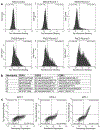Development of a pan-tau multivalent nanobody that binds tau aggregation motifs and recognizes pathological tau aggregates
- PMID: 38568030
- PMCID: PMC11447142
- DOI: 10.1002/btpr.3463
Development of a pan-tau multivalent nanobody that binds tau aggregation motifs and recognizes pathological tau aggregates
Abstract
Alzheimer's disease and other tauopathies are characterized by the misfolding and aggregation of the tau protein into oligomeric and fibrillar structures. Antibodies against tau play an increasingly important role in studying these neurodegenerative diseases and the generation of tools to diagnose and treat them. The development of antibodies that recognize tau protein aggregates, however, is hindered by complex immunization and antibody selection strategies and limitations to antigen presentation. Here, we have taken a facile approach to identify single-domain antibodies, or nanobodies, that bind to many forms of tau by screening a synthetic yeast surface display nanobody library against monomeric tau and creating multivalent versions of our lead nanobody, MT3.1, to increase its avidity for tau aggregates. We demonstrate that MT3.1 binds to tau monomer, oligomers, and fibrils, as well as pathogenic tau from a tauopathy mouse model, despite being identified through screens against monomeric tau. Through epitope mapping, we discovered binding epitopes of MT3.1 contain the key motif VQIXXK which drives tau aggregation. We show that our bivalent and tetravalent versions of MT3.1 have greatly improved binding ability to tau oligomers and fibrils compared to monovalent MT3.1. Our results demonstrate the utility of our nanobody screening and multivalent design approach in developing nanobodies that bind amyloidogenic protein aggregates. This approach can be extended to the generation of multivalent nanobodies that target other amyloid proteins and has the potential to advance the research and treatment of neurodegenerative diseases.
Keywords: Alzheimer's disease; aggregate; amyloid; multivalency; nanobody; tau; yeast surface display.
© 2024 The Authors. Biotechnology Progress published by Wiley Periodicals LLC on behalf of American Institute of Chemical Engineers.
Conflict of interest statement
Figures





References
MeSH terms
Substances
Grants and funding
LinkOut - more resources
Full Text Sources

